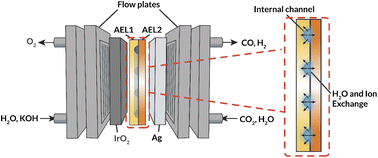Anion-exchange membranes with internal microchannels for water control in CO2 electrolysis†
Abstract
Electrochemical reduction of carbon dioxide (CO2R) poses substantial promise to convert abundant feedstocks (water and CO2) to value-added chemicals and fuels using solely renewable energy. However, recent membrane-electrode assembly (MEA) devices that have been demonstrated to achieve high rates of CO2R are limited by water management within the cell, due to both consumption of water by the CO2R reaction and electro-osmotic fluxes that transport water from the cathode to the anode. Additionally, crossover of potassium (K+) ions poses concern at high current densities where saturation and precipitation of the salt ions can degrade cell performance. Herein, a device architecture incorporating an anion-exchange membrane (AEM) with internal water channels to mitigate MEA dehydration is proposed and demonstrated. A macroscale, two-dimensional continuum model is used to assess water fluxes and local water content within the modified MEA, as well as to determine the optimal channel geometry and composition. The modified AEMs are then fabricated and tested experimentally, demonstrating that the internal channels can both reduce K+ cation crossover as well as improve AEM conductivity and therefore overall cell performance. This work demonstrates the promise of these materials, and operando water-management strategies in general, in handling some of the major hurdles in the development of MEA devices for CO2R.



 Please wait while we load your content...
Please wait while we load your content...